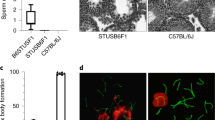Abstract
SYSTEMIC treatment of the pregnant doe with suitable preparations, for example stilbœstrol, results in the destruction of the entire litter1. However a surgical approach is required in order to destroy selected embryos. Huggett and Pritchard2 induced prenatal mortality in rats by crushing the fœtuses with toothed forceps through the intact uterine wall at laparotomy. Later, Frazer3 employed this technique to produce a standard number of implantations by destroying any in excess of the desired number. In rabbits, Brambell et al. 1 also used a surgical technique to kill embryos on the 16th or 19–20th days of pregnancy ; in some animals attempts were made to-kill the entire complement of embryos while in others only some of the embryos were treated. The technique consisted of perforating the uterine swellings through the antimesometrial wall of the uterus and stabbing at the embryos with a fine suture needle. Rather surprisingly several of the embryos survived this treatment. During experiments on rabbits4 concerning the distribution of embryonic death after implantation, it became necessary to ascertain the effect of the stage of pregnancy when death occurred on the resorption of dead embryos and their placentæ in litters that survived to term. Accordingly, a technique was developed whereby embryos could be killed selectively between the 7th and 17th days of pregnancy. It is the purpose of this communication to describe the application of this technique, which proved to be highly successful.
This is a preview of subscription content, access via your institution
Access options
Subscribe to this journal
Receive 51 print issues and online access
$199.00 per year
only $3.90 per issue
Buy this article
- Purchase on Springer Link
- Instant access to full article PDF
Prices may be subject to local taxes which are calculated during checkout
Similar content being viewed by others
References
Brambell, F. W. R., Henderson, M., and Mills, I. H., J. Exp. Biol., 25, 209 (1948).
Huggett, A. St. G., and Pritchard, J. J., Proc. Roy. Soc. Med., 38, 261 (1945).
Frazer, J. F. D., J. Embryol. Exp. Morph., 3, 13 (1955).
Adams, C. E., J. Endocrinol., 19, 325 (1960).
Jost, A., in “The Mammalian Foetus: Physiological Aspects of Development” (The Biological Laboratory, Cold Spring Harbor, Long Island, New York) (1954).
Author information
Authors and Affiliations
Rights and permissions
About this article
Cite this article
ADAMS, C. Embryonic Mortality induced Experimentally in the Rabbit. Nature 188, 332–333 (1960). https://doi.org/10.1038/188332a0
Issue Date:
DOI: https://doi.org/10.1038/188332a0
Comments
By submitting a comment you agree to abide by our Terms and Community Guidelines. If you find something abusive or that does not comply with our terms or guidelines please flag it as inappropriate.



